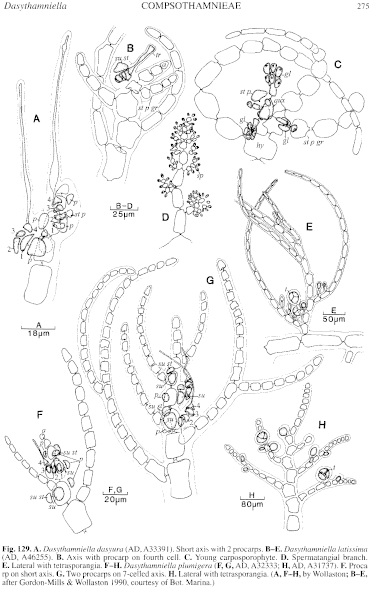|
|
|
|
|
|||||||||||
|
Electronic Flora of South Australia Species Fact Sheet
Phylum Rhodophyta – Order Ceramiales – Family Ceramiaceae – Tribe Compsothamnieae
Synonyms
Callithamnion dasyurum Harvey 1863, synop.: li. J. Agardh 1876: 49. Sonder 1881: 10.
Spongoclonium dasyurum (Harvey) J. Agardh 1894a: 118. De Toni 1903: 1363. Lucas 1909: 50; 1927: 466, pl. 31.
Dasythamnion setosum J. Agardh 1894a: 120, pl. II figs 4–7. De Toni 1903: 1358.
Dasythamniella setosa (J. Agardh) Silva 1970: 942.
Thallus (Fig. 127A) erect, medium to dark red-brown, 5–20 (–30) cm high, with a well developed and densely corticated main axis and laterals (usually 1–10 cm long) for 2–4 orders, more or less distichously branched, ultimate branches often plumose; axes 1–3 mm in diameter. Holdfast conical, 2–10 (–15) mm across, rhizoidal; epilithic. Structure. Active apices (Fig. 127B) with cells dividing by transverse to slightly oblique walls (usually oblique at laterals), distichously alternately branched, apical cells 15–25 lint in diameter and L/D 1–1.5, axial cells increasing from 40–60 µm in diameter and L/D 1–1.5 (–2) shortly below apices to 100–200 µm in diameter and L/D 0.8–2 in lower thallus. Determinate branchlets 1–3 mm long, simple or basally branched 1–3 times, ultimate filaments (Fig. 127C) becoming 1–2 mm and 20–50 (–70) cells long, tapering only slightly until near their ends, 25–45 µm in diameter with cells L/D (0.7–) 1–1.5 (–2). Indeterminate lateral branches developing from determinate branchlets. Lower and mid axes and branches heavily corticated by entwined rhizoids 12–25 µm in diameter with cells L/D 1–5, produced from basal cells of laterals. Cells multinucleate; rhodoplasts discoid.
Reproduction: Gametophytes dioecious. Procarps (Fig. 127D) on usually the third and often the fourth cell (Fig. 129A) of short branches 4–5 cells long, with two periaxial cells, the first (supporting) cell cutting off a sterile cell and a 4-celled carpogonial branch; the sterile periaxial cell may also cut off an apical cell. Carposporophytes with basal cells fusing but without a distinctive fusion cell; gonimolobes (Fig. 127E) 1–4, 300–750 µm across, successively developed, rounded, carposporangia 10–25 µm across; carposporophytes terminal on short lateral branches, densely surrounded by curved branchlets from lower cells. Spermatangia heads (Fig. 127F) ovoid, 27–45 µm in diameter and L/D 1.8–2.1.
Tetrasporangia (Fig. 127G) on pedicels 1–5 cells long, becoming clustered by branching from pedicels, situated on lower to mid cells of determinate ramuli, subspherical, 25–45 µm in diameter, tetrahedrally divided (very rarely octosporangia).
Type from Port Philip Heads, Vic. (Harvey); lectotype (Harvey, Tray. Set 426); also Alg. Aust. Exsicc. 505, in Herb. Harvey, TCD.
Selected specimens: Gulf St Vincent, S. Aust., deep water (AD, A63582). Encounter Bay, S. Aust. (Hussey; MEL, 608415). Robe, S. Aust., drift (Wollaston, 13.iii.1955; AD, A19901). Stinky Bay, Nora Creina, S. Aust., drift (Wollaston, 27.i.1969; AD, A33391) and (Womersley, 26.x.1996; AD, A67120). 1.3 km off Cape Northumberland, S. Aust., 15 m deep (Shepherd, 13.0.1976; AD, A55337). Point Lonsdale, Vic., drift (Hansen, Jan. 1955; AD, A20447). Tasman I., S Tas., 20 m deep (Riddle, 1.iii.1990; AD, A60499).
Distribution: Gulf St Vincent, S. Aust., to Port Phillip Heads, Vic., and S Tasmania.
Taxonomic notes: D. setosum J. Agardh is represented in Herb. Agardh by a single specimen (Encounter Bay, S. Aust., Hussey, LD, 18868). It is a robust and old specimen of D. dasyura. The species is an elegant and well-marked taxon with its distichous thallus and plumose branch ends, developing long unbranched filaments with short cells in the determinate branchlets.
References:
AGARDH, J.G. (1876). Species Genera et Ordines Algarum. Vol. 3, Part 1- Epicrisis systematic Floridearum, pp. i-vii, 1–724. (Weigel: Leipzig.)
AGARDH, J.G. (1894a). Analecta Algologica. Cont. I. Acta Univ. lund. 29, 1–144, Plates 1, 2.
DE TONI, G.B. (1903). Sylloge Algarum omnium hucusque Cognitarum. Vol. 4. Florideae. Sect. 3, pp. 775–1521 + 1523–1525. (Padua.)
HARVEY, W.H. (1863). Phycologia Australica. Vol. 5, Plates 241–300, synop., pp. i-lxxiii. (Reeve: London.)
LUCAS, A.H.S. (1909). Revised list of the Fucoideae and Florideae of Australia. Proc. Linn. Soc. N.S.W. 34, 9–60.
LUCAS, A.H.S. (1927). Notes on Australian marine algae. IV. The Australian species of the genus Spongoclonium. Proc. Linn. Soc. N.S.W. 52, 460–470, Plates 27–35.
SILVA, P.C. (1970). Remarks on algal nomenclature. IV. Taxon 19, 941–945.
SONDER, O.W. (1881). In Mueller, F., Fragmenta Phytographiae Australiae. Supplementum ad volumen undecinum: Algae Australianae hactenus cognitae, pp. 1–42, 105–107. (Melbourne.)
The Marine Benthic Flora of Southern Australia Part IIIC complete list of references.
Publication:
Womersley, H.B.S. (24 December, 1998)
The Marine Benthic Flora of Southern Australia
Rhodophyta. Part IIIC. Ceramiales – Ceramiaceae, Dasyaceae
©State Herbarium of South Australia, Government of South Australia
Illustrations in Womersley Part IIIA, 1998: FIGS 127, 129A.

Figure 127 enlarge
Fig. 127. Dasythamniella dasyura (A, C, D, AD, A33391; B, E,G, AD, A67120; F, AD, A60499). A. Habit. B. Apex of indeterminate axis with distichous lateral branchlets. C. Long ultimate filaments. D. Procarps on third cells of short branches. E. Rounded gonimolobes. F. Spermatangial heads. G. Branch with tetrasporangia.

Figure 129 enlarge
Fig. 129. A. Dasythamniella dasyura (AD, A33391). Short axis with 2 procarps. B–E. Dasythamniella latissima (AD, A46255). B. Axis with procarp on fourth cell. C. Young carposporophyte. D. Spermatangial branch. E. Lateral with tetrasporangia. F–H. Dasythamniella plumigera (F, G, AD, A32333; H, AD, A31737). F. Procarp on short axis. G. Two procarps on 7-celled axis. H. Lateral with tetrasporangia. (A, F–H, by Wollaston; B–E, after Gordon-Mills & Wollaston 1990, courtesy of Bot. Marina.)

|
Email Contact: State Herbarium of South Australia |

|